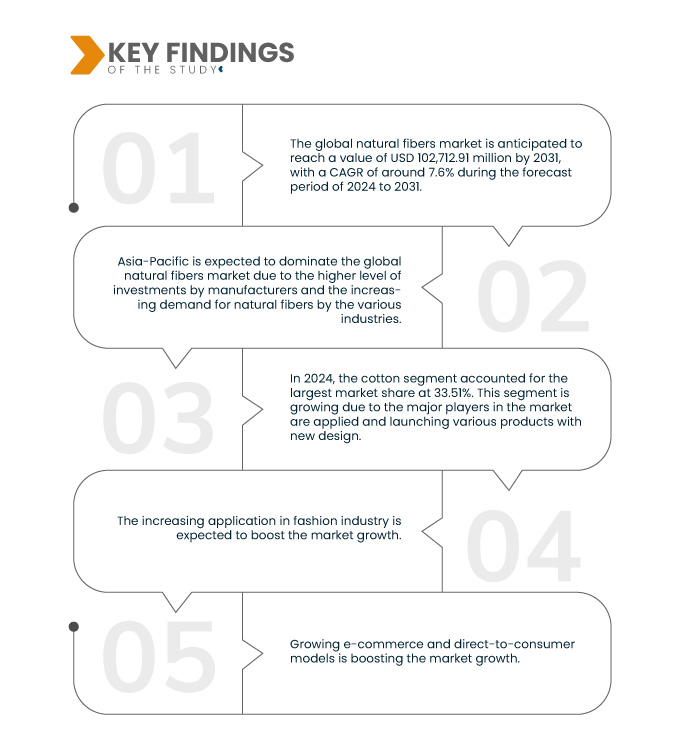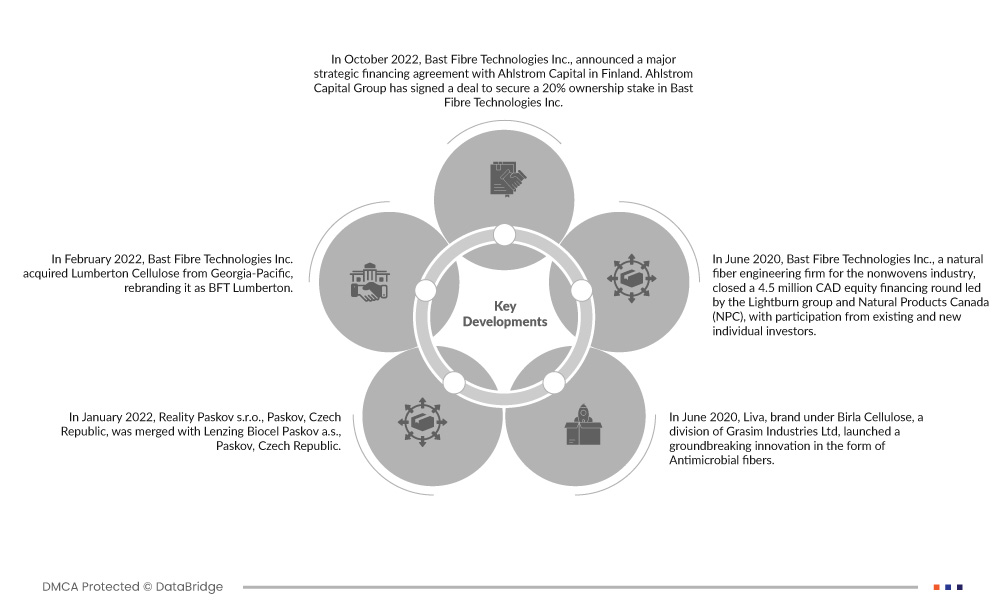Natural fibers are organic materials used in textiles that come from unprocessed, raw sources such as plants, animals, or minerals. Humans have been using these fibers for ages to make a vast range of goods, such as textiles, clothes, and more. Natural fibers come straight from nature and are not intentionally produced, in contrast to synthetic or man-made fibers. Typical natural fibers include plant-based materials like cotton, flax (linen), jute, and animal-based materials such as cashmere, wool, and silk. Natural fibers are a vital component of the textile industry because of their distinctive qualities, eco-friendliness, and biodegradability in a variety of applications.
Access Full Report @ https://www.databridgemarketresearch.com/reports/global-natural-fibers-market
Data Bridge Market Research analyzes that the Global Natural Fibers Market is expected to grow at a CAGR of 7.6% in the forecast period of 2024 to 2031 and is expected to reach USD 102,712.91 million by 2031. The cotton segment is projected to propel the market growth due to the growing demand and usage among the various industries.
Key Findings of the Study
Advancement in the Application of Natural Fibers in the Packaging Industry
The advancement in the application of natural fibers in the packaging industry is becoming a pivotal driving force behind the global natural fibers market. This transformative trend is characterized by a growing awareness of sustainable packaging solutions and a strong shift towards eco-friendly materials in response to the pressing need for environmental conservation. Natural fibers, derived from sources such as jute, flax, and kenaf, are increasingly finding their place in various packaging applications, presenting an environmentally responsible alternative to traditional synthetic materials. One of the key factors propelling the use of natural fibers in the packaging industry is their biodegradability and renewability. These fibers are inherently eco-conscious, as they decompose naturally and can be regenerated, minimizing the environmental impact of packaging waste. This aligns with the global movement towards reducing plastic usage and its associated pollution, making natural fiber-based packaging an attractive choice for businesses and consumers alike.
Thus, the advancement in the application of natural fibers in the packaging industry is a driving factor behind the expansion of the global natural fibers market. Their eco-friendliness, renewability, and adaptability in packaging design make them an attractive choice for a world increasingly concerned about ecological conservation. The synergy between the packaging sector's growing demand for sustainable solutions and the natural fiber market's offerings is poised to shape the future of environmentally responsible packaging, making it a prominent player in the ongoing effort to create a greener, more sustainable world.
Report Scope and Market Segmentation
|
Report Metric
|
Details
|
|
Forecast Period
|
2024 to 2031
|
|
Base Year
|
2023
|
|
Historic Year
|
2022 (Customizable 2016-2021)
|
|
Quantitative Units
|
Revenue in USD Million
|
|
Segments Covered
|
Fibers (Cotton, Wool, Flax, Silk, Jute, Hemp, Sisal, Kenaf, and Others), Distribution Channel (Manufacturers, Distributors, Wholesalers, Retailers, and Others), Application (Fashion & Clothing, Furnishing & Home, and Industrial & Technical)
|
|
Countries Covered
|
U.S., Canada, Mexico, Germany, Italy, U.K., France, Switzerland, Spain, Russia, Turkey, Belgium, Netherlands and the Rest of Europe, China, India, South Korea, Hong Kong, Japan, Thailand, Australia & New Zealand, Singapore, Indonesia, Malaysia, Philippines, Taiwan, and Rest of Asia-Pacific, Brazil, Argentina, Rest of South America, Saudi Arabia, U.A.E., South Africa, Egypt, Israel and Rest of Middle East and Africa
|
|
Market Players Covered
|
Vardhaman Textiles Limited (India), Grasim Industries Limited (India), ANANDHI TEXSTYLES (India), Bcomp (Switzerland), The Natural Fibre Company (U.K.), Procotex (Belgium), FlexForm Technologies (U.S.), Bast Fiber Technologies Inc. (Canada), Lenzing AG (Austria), Barnhardt Natural Fibers (U.S.), among others.
|
|
Data Points Covered in the Report
|
In addition to the insights on market scenarios such as market value, growth rate, segmentation, geographical coverage, and major players, the market reports curated by the Data Bridge Market Research also include in-depth expert analysis, geographically represented company-wise production and capacity, network layouts of distributors and partners, detailed and updated price trend analysis and deficit analysis of supply chain and demand.
|
Segment Analysis
Global natural fibers market is segmented into three notable segments based on fibers, distribution channel, and application.
- On the basis of fibers, the global natural fibers market is segmented into cotton, wool, flax, silk, jute, hemp, sisal, kenaf, and others
In 2024, the cotton segment of the fibers segment is expected to dominate the global natural fibers market
In 2024, the cotton segment is expected to dominate the market due to the rising demand for natural fibers among the population with a market share of 33.51%.
- On the basis of distribution channel, the global natural fibers market is segmented into manufacturers, distributors, wholesalers, retailers, dealers, and others.
In 2024, the manufacturers segment of the distribution channel segment is expected to dominate the global natural fibers market
In 2024, the manufacturers segment is expected to dominate the market due to the easy accessibility of the products with a market share of 40.18%.
- On the basis of application, the global natural fibers market is segmented into fashion & clothing, furnishing & home, and industrial & technical. In 2024, the industrial & technical segment is expected to dominate the market with a market share of 46.42%.
Major Players
Data Bridge Market Research analyzes Vardhaman Textiles Limited (India), Grasim Industries Limited (India), Bcomp (Switzerland), Lenzing AG (Austria), Barnhardt Natural Fibers (U.S.), as the major market players in the global natural fibers market.
Market Development
- In October 2022, Bast Fibre Technologies Inc. announced a major strategic financing agreement with Ahlstrom Capital in Finland. Ahlstrom Capital Group has signed a deal to secure a 20% ownership stake in Bast Fibre Technologies Inc. This will facilitate an immediate expansion of their fiber production operations.
- In February 2022, Bast Fibre Technologies Inc. acquired Lumberton Cellulose from Georgia-Pacific, rebranding it as BFT Lumberton. This expansion will raise their annual manufacturing capacity to over 30,000 tonnes, solidifying their position as a major natural fiber processing hub in North America.
- In January 2022, Reality Paskov s.r.o., Paskov, Czech Republic, was merged with Lenzing Biocel Paskov a.s., Paskov, Czech Republic. This will facilitate the future growth and expansion of their business.
- In June 2020, Liva, brand under Birla Cellulose, a division of Grasim Industries Ltd, launched a groundbreaking innovation in the form of Antimicrobial fibers. These fibers not only eliminate viruses and bacteria but also impede their proliferation, ensuring that the fabric remains clean and hygienic over an extended period. These sort of innovative product launch has helped the company to gain a competitive edge over the market.
- In June 2020, Bast Fibre Technologies Inc., a natural fiber engineering firm for the nonwovens industry, closed a 4.5 million CAD equity financing round led by the Lightburn group and Natural Products Canada (NPC), with participation from existing and new individual investors. This helped in the expansion of their fiber production operations.
Regional Analysis
Geographically, the countries covered in the thr global natural fibers market report are the U.S., Canada, Mexico, Germany, Italy, U.K., France, Switzerland, Spain, Russia, Turkey, Belgium, Netherlands and the Rest of Europe, China, India, South Korea, Hong Kong, Japan, Thailand, Australia & New Zealand, Singapore, Indonesia, Malaysia, Philippines, Taiwan, and Rest of Asia-Pacific, Brazil, Argentina, Rest of South America, Saudi Arabia, U.A.E., South Africa, Egypt, Israel and Rest of Middle East and Africa.
As per Data Bridge Market Research analysis:
Asia-Pacific is expected to dominate and be the fastest-growing region in the global natural fibers market
Asia-Pacific is expected to dominate the market and be the fastest-growing region in the market owing to the higher level of investments by manufacturers and the increasing demand for natural fibers by various industries. Also, the rising globalization and industrialization of the textile industry will boost market growth. Asia-Pacific will continue to dominate the market in terms of market share and market revenue and will continue to flourish its dominance during the forecast period.
For more detailed information about the global natural fibers market report, click here – https://www.databridgemarketresearch.com/reports/global-natural-fibers-market












